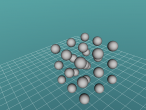Sodium Fluoride

Sodium fluoride is a molecule which is made up of sodium (Na) and fluoride (F) with a ration of 1:1. The blog presented will be describing and explaining the composition, structure and characteristics of this molecule. It's most common use, as afore mentioned is in toothpaste, where it strengthens the teeth, and makes them more resistant to decay caused by acidic substances and bacteria. Sodium toxic is highly toxic and can be lethal to humans if ingested in large quantities. This makes it effective for rat poisons and insecticides. It also is used as a cleaning agent.
Sodium Fluoride is composed of 45.25% Fluoride and 54.75% Sodium. This can be rounded to a figure of 50/50. Similar to sodium chloride, it crystallises in a cube motif. Its lattice spacing, approximately 462 pm, is somewhat smaller than that of sodium chloride. In mineral form, it is known as villiaumite.
This compound has a molecular weight of 41.99g/mol. It has a density of 1.02g/ml at the temperature of 20 degrees Celsius, has a melting point of 993 degrees Celsius and a boiling point of 1700 degrees Celsius. In a solid state, sodium fluoride is colourless and odourless. The substance is soluble in water and in small quantities, can be beneficial for your teeth. However, if the amount exceeds 5g, it can extremely harmful and in some cases, fatal for humans. Sodium fluoride can reach with acids to become corrosive and highly potent. If ingested or inhaled at non-lethal rates, it can still cause side effects such as vomiting, abdominal pain, diarrhea, convulsions, collapse, thirst, disturbed color vision, and acute toxic nephritis. It is not flammable, however, it can decompose when exposed to heat, and produce corrosive and toxic fumes.
There are still questions raised about the compound. For instance, would sodium fluoride by itself react the same way if used for the purposes of salt? Another question which could be investigated is that is it similar to other molecules pertaining fluoride?
Interesting features about this molecule which I wish to investigate more in is the methods used to create 3D models, and the simplicity of the program which yet, allows it to create complex animations. Things I struggled with include checking for bugs in the coding and also some of the terms.
links
http://www.chemicalbook.com/ChemicalProductProperty_EN_CB8854278.htm
https://en.m.wikipedia.org/wiki/Sodium_fluoride
https://pubchem.ncbi.nlm.nih.gov/compound/sodium_fluoride#section=Top
Groups:
























